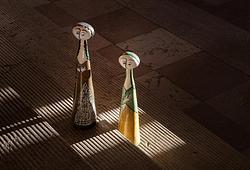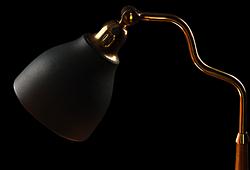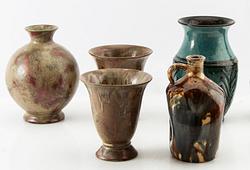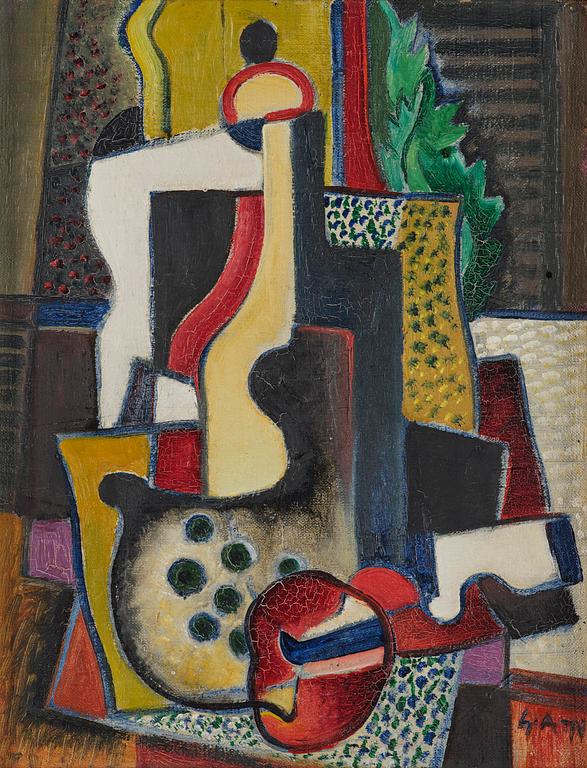Gösta Adrian-Nilsson
"Nature morte I"
Signed G.A-N. Canvas panel 35 x 27 cm.
Alkuperä - Provenienssi
Nils and Alice Wedel.
Thence by descent.
Kirjallisuus
"Svenska hem i ord och bilder", 1942, "Hos Nils och Alice Wedel", illustrated p. 36.
Muut tiedot
Originally a Christmas gift from Gösta Adrian-Nilsson (GAN), the painting is part of the collection of the artist couple Nils and Alice Wedel. GAN was a close friend of the family from their youth in Paris, and the friendship lasted a lifetime.
‘Nature Morte I’ testifies to GAN's artistic reorientation during the five years he lived in Paris, 1920-1925. Behind him was a period in which he fused influences from the Futurists' worship of movement, the Cubists' new pictorial space and a kaleidoscope of colour and star patterns.
Jan Torsten Ahlstrand writes:
"Gösta Adrian-Nilsson (GAN) had the good fortune to descend on the European art scene at the right moment on two different occasions: in Berlin in 1913 and in Paris in 1920. In Berlin, the formerly wicked symbolist from Lund was converted to the new isms of continental modernism, of which he created a highly personal synthesis. When he arrived in Paris in June 1920 and got to know Fernand Léger, he was already moving towards a more unified Cubism in the spirit of Synthetic Cubism. GAN admired Léger's masculine and formal machine cubism, but unlike many others in the 1920s avant-garde, he was not a follower of Léger."
GAN's synthetic cubism was rich in detail and strong colours, which distinguished him from the more austere Léger. The painting in this auction, “Nature Morte I”, is composed of a number of forms that extend vertically across the painting in several planes. The eye perceives a still life with a palette, a fruit, a knife and a bottle, but the forms seem to float freely without being anchored in space. The colouring of the various planes in yellow and red highlights the subject, framed in Léger's manner by white fields, against the muted background.
The painting is signed G.A-N with the lingering futuristic, lightning-shaped G and was probably executed between 1920 and 1923 in Paris. ‘Nature Morte I’ is a clear example of GAN's versatility and experimentation - he is on the verge of further developing his synthetic cubism. In the painting Composition with Letters (Vive la cubisme) from 1921 and in two still lifes from 1922 and 1923, he intersperses letters, pieces of paper and tickets in the picture, and the signature changes to a unified cubist form with three capitals.
In 1925, GAN leaves Paris and settles back in his hometown of Lund. The friendship with the Wedel family is resumed, and GAN becomes a regular guest in their home. He was often present at Christmas celebrations and sometimes brought Christmas presents for the children - framed drawings and works in tempera or oil. Alice and Nils Wedel's collection included a number of early works by GAN.
In the publication “Svenska Hem i Ord och Bilder” (Swedish Homes in Words and Pictures) from 1942, there is an illustrated story about the home of the Alice and Nils Wedel family on Jaktgatan in Örgryte. The painting in this auction is depicted in one of the interior photos from the artists' home. The shared studio was in the attic of the house, and ajoining there were the two boys' rooms. Gösta Adrian-Nilsson's “Nature Morte I” is placed on the wall by one of the beds - a gift to one of the children and a memory from Paris in the early 1920s.
Pictures:
GAN, "Nature Morte I", in one of the boys rooms at Jaktgatan, Örgryte. Photo: Carl Gemler for "Svenska Hem i Ord och Bilder", 1942.
Nils Wedel and Gösta Adrian-Nilsson, Frostavallen, 1935. Photo: Private


















































